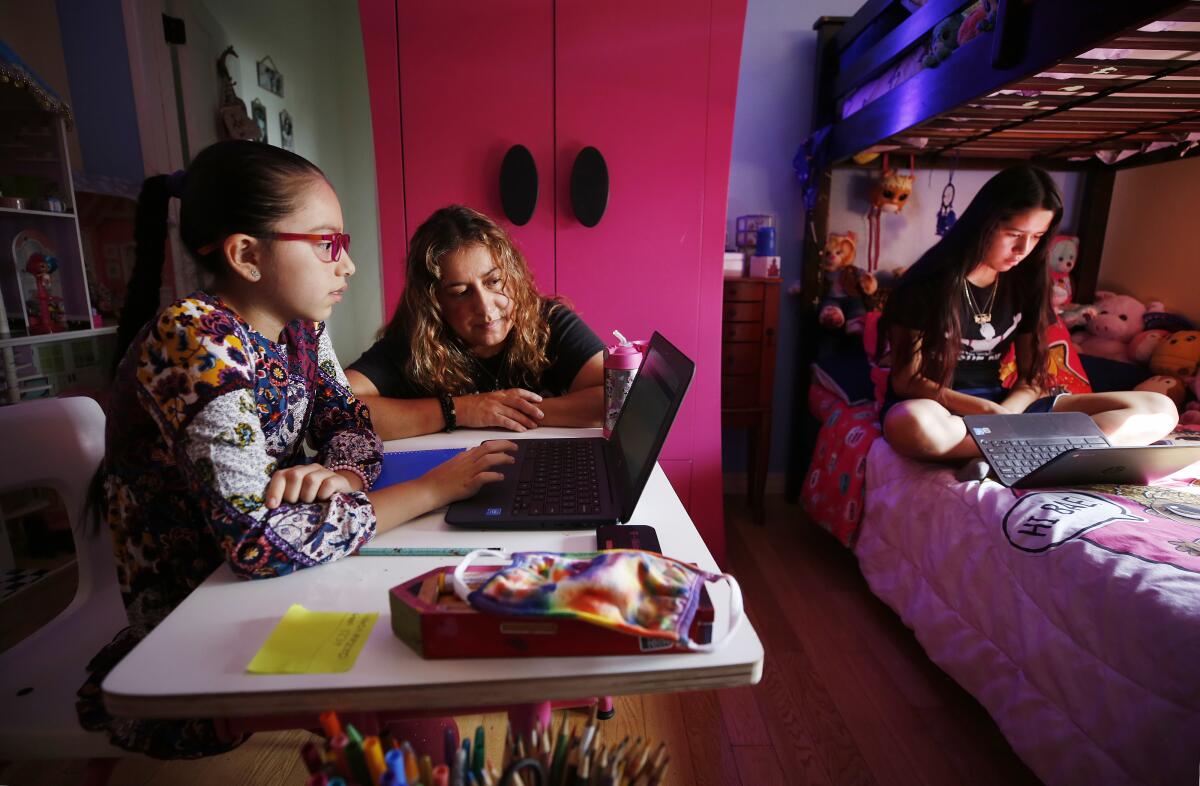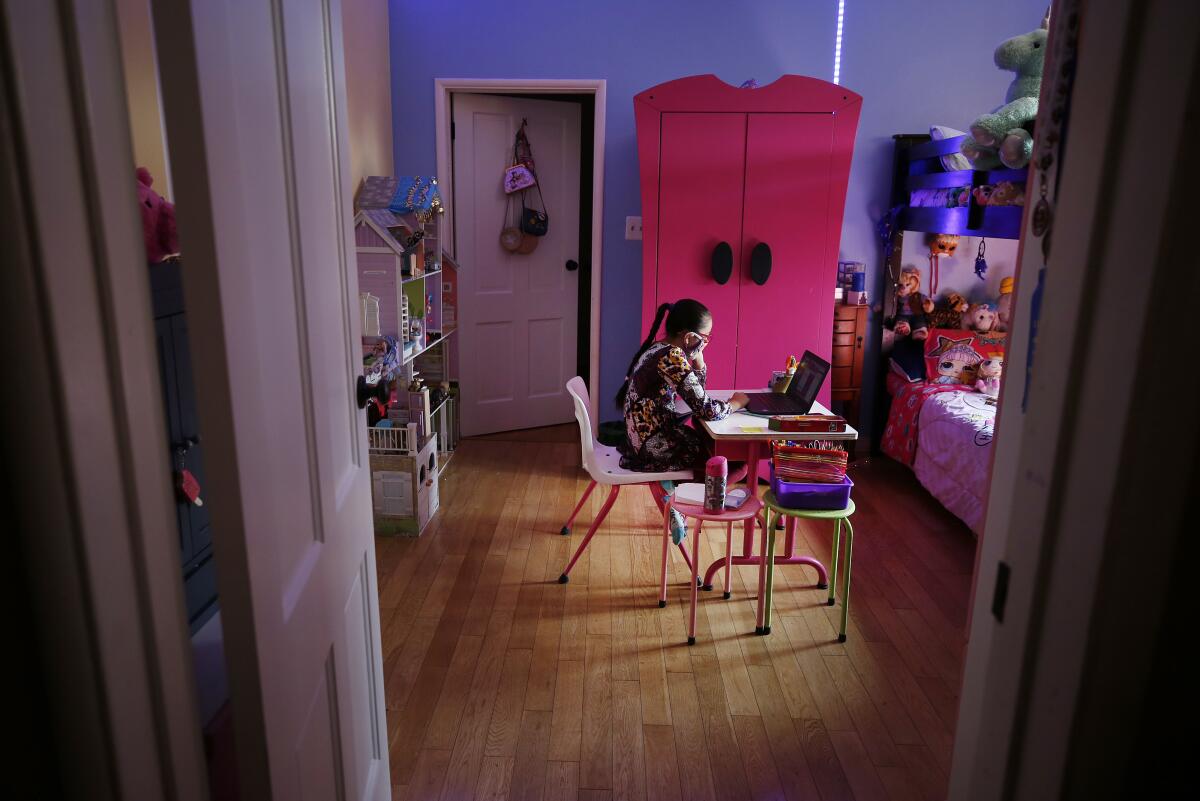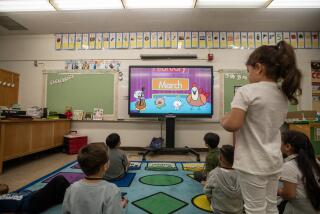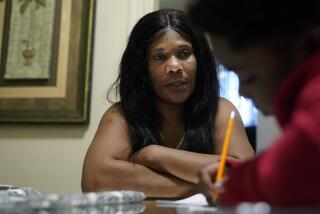Remote learning has created a new audience for an old ritual: Crying in school

During the second week of distance learning, 6-year-old Ezra Karpf clicked the “unmute” button on his computer screen so he could ask his teacher a question. It didn’t work.
Ezra’s frustration simmered. Then it peaked. Then it exploded.
“I can’t unmute myself! I can’t unmute myself!” he shouted repeatedly until his mother rushed over.
The class came to a standstill. The boy moved off-screen, like a frustrated actor storming off the stage — weeping before his rapt, digital audience.
“My son was sobbing on the floor,” said his mother, Courtney Patterson, 44, of Silver Spring, Md. “He didn’t want to get back to class. He didn’t want the class to see him crying.”
Crying has been a ritual of school life for time immemorial. First-day jitters. Stage fright during a first play. Run-in with a bully. Best friend leaves for another friend. Tetherball to the face.
But never before has the simple act of a child weeping had such a vast and motley audience: Teachers, parents, fellow students and others participating in the often white-knuckle experiment that is remote learning in the age of the novel coronavirus.
Technology, which so many children love, has become a town crier blasting out their pain.
As the pandemic drags on, Zoom and other platforms used to teach children have provided a stage for emotional breakdowns. Some children manage to move off-screen as the tears flow; others turn their back to the computer screen, tugging at their shirts to dry the welling tears in an often fruitless attempt to hide their feelings.
“There’s just so much going on for anyone,” said Yalda T. Uhls, an assistant adjunct professor of psychology and executive director of the Center for Scholars and Storytellers at UCLA. “But at least adults have gone through other major catastrophes. For [children] that age, moving around, being physical, singing, dancing, all that stuff is really important, and that’s been cut out of their lives.”
Ezra said he cried because he felt like no one could hear him — and because, when he’s home, he’d rather be playing with his superhero toys.
“I wanted to tell my teacher how long until it was lunchtime,” the boy said. “It’s a little boring sitting in my little chair. And sitting for a long time. It’s not fun.”
Rattled parents across the U.S. have shared experiences of their children crying on social media. In late August, a photograph of a 5-year-old boy wiping his tears away with his shirt in front of his laptop went viral after his mother posted it online.
“I just took that picture because I wanted people to see reality,” the boy’s mother told CNN. “And then he came over and we hugged, and I was crying right along with him.”
In the San Bernardino County town of Crestline, 5-year-old Anthony Stever had an unexpected reaction to the teacher’s announcement of a 10-minute break. Like a frustrated office worker who had decided the day had already soured, he shut his laptop.
Then he reached for a toy dinosaur and called it a day.
His mother, Jane Marie DeRosa, 32, tried calling him back.
“We were trying to be stern with him but not too stern,” she said. “So he started crying and got all upset. He didn’t want to go back.”
When he’s not crying, Anthony is frequently distracted. He fidgets and logs off Zoom. He’ll tell his parents: “No, it’s too late, it’s too late,” as a way to avoid joining class. During class, he comes up with excuses like, “I need a blankie,” or “I’m thirsty,” his mother said.
Sometimes, his mother, father or grandmother will have to hold him and comfort him before he’s able to return to his lessons. He has company: He’s far from the only child in his class who gets distracted, starts eating during class or leaves altogether.
Whether the schooling is happening in person or virtually, tantrums and tears happen when children aren’t having basic physiological and security needs met, said Carolina Valdez, professor of elementary and bilingual education at Cal State Fullerton.
Valdez, whose expertise includes trauma-informed pedagogy, added that young children in particular often haven’t learned how to communicate their needs.
Whether the adults in the room notice or not, children are absorbing news about the chaos or unrest in the world. They often perceive that things are not normal. They may struggle to sleep at night knowing their parents are stressed, or they may lose their appetite because of their own anxiety, Valdez said.
“Most schools aren’t teaching emotional literacy,” she said. “They’re not teaching kids how to name their feelings, how to be present with their feelings, how to process this in a healthy way.”
In the not-so-distant past, home was at least a shelter from the outside world into which only family and close friends came, Valdez said. Now, everyone gets a peek into children’s refuge — whether they like it or not. For the first time, a teacher is also controlling their movement in their own home, Valdez said.
“Teachers are attempting to police students’ movements the way they probably did in their classrooms,” she said.
Uhls, the psychology professor, said she recommends parents be honest with their children about their own limits and what’s going on in the world.
“Adults should really be talking to them about this stuff in an appropriate way for young children,” she said, adding that parents can tell their kids: “Yes, this is a strange time, and sometimes Mommy and Daddy get worried, but we’re taking care of you and you’re going to be safe.”
It’s a strategy that 47-year-old Sofia Quezada tries to use with her youngest daughter.
On her first day of remote learning, 9-year-old Priscilla Guerrero woke up extra early in her Boyle Heights home, did her hair and put on a cute outfit with the same excitement she did every other first day of school. But when she tried logging into Zoom, she got an error message.

Quezada, who works from home as an administrator for the UCLA School of Medicine, tried helping her restart the program. After a handful of attempts, Priscilla broke down in tears.
“She kept telling me, ‘Mommy, I’m gonna be late, I’m gonna be in big trouble,’” Quezada said. “I had to talk her down from her complete panic attack.”
Quezada said she had to quell her daughter’s fear of her teachers being upset with her by explaining that everyone is going through a tough time.
Around the dining table, Quezada and her husband talk openly about the coronavirus, elections and whatever else may be happening in the world. They try to answer all of their girls’ questions.
Quezada said she tells her daughters: “Whatever is happening in the world right now is scary and it sucks, but we’re going to get through this. Yeah, we may get a little behind, but we will catch up. It’s not a race.”
Jennifer Morgan, a kindergarten teacher in a small, private Christian school in an affluent San Diego neighborhood, said that during remote lessons earlier in the year, her students would duck under tables, get distracted or suddenly decide to showcase their pets to the class.
These actions didn’t disrupt the class too much, she said. All the kids had their own laptops and at least one parent was always around. Unlike in poor neighborhoods, many of the parents were tech-savvy.
Because of her small class size, she was able to research teaching tools to help her students understand the current moment. She read them books about mask-wearing and sang songs about the coronavirus and how to manage emotions.
Experts say this type of emotional literacy should be taught in classrooms now. But budget cuts make it unlikely that schools will invest in such professional development for teachers.
“I think social-emotional learning is becoming more of a priority in the school system, but [current teachers] are not trained in it,” Uhls said. “Teachers aren’t trained enough in a lot of things in America.”
Morgan said that although her experience has been better, it’s a different story for teachers at public schools. From friends, she hears stories of only a third of students showing up to class.
At Morgan’s school, her 15-student class is back in session — no more remote learning. Plastic sheets divide desks and masks are required while the students move through the room.
“I think this has highlighted inequity so much,” said Morgan, who used to teach at public schools in Los Angeles and Pasadena. “Inequity in family situations, in financial situations, in language and technology capabilities. I think, ‘Gosh, if I had done this when I taught at a different school, it would have been so hard.’”
At home, Morgan’s husband, Glenn, struggles with the balance of teaching his own high school literature classes while keeping an eye on their 9-year-old daughter, Tess, who is on the autism spectrum.
While he teaches the group of teenagers, they can see Tess studying in the background. Tess sometimes taps her dad on the shoulder to ask him for help or to keep his voice down.
There haven’t been any tantrums, but she gets distracted, her parents said. They offer incentives to get her to her desk, such as an afternoon at the swimming pool or a treat.
“Mostly it’s been like, ‘OK, honey, you have to get on the Zoom for this class,’” her father said.
“We have another Zoom?” she responds. “Ugh, gosh!”
More to Read
Start your day right
Sign up for Essential California for news, features and recommendations from the L.A. Times and beyond in your inbox six days a week.
You may occasionally receive promotional content from the Los Angeles Times.







